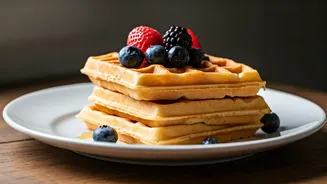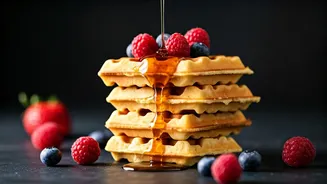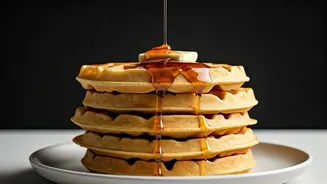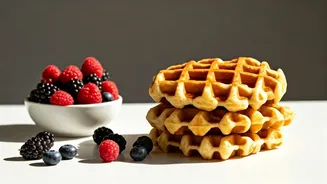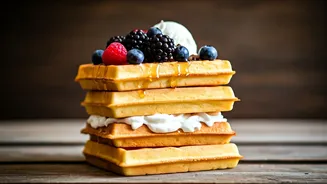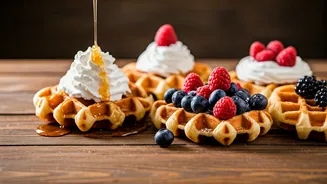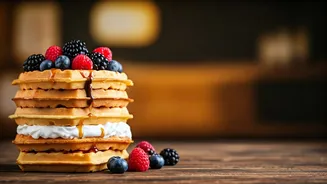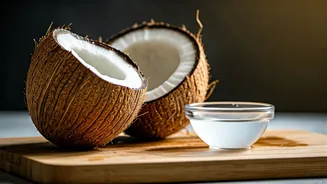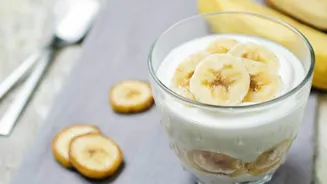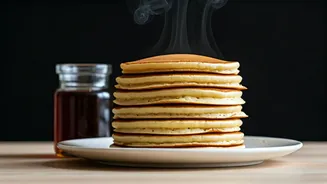Waffle Origins & Appeal
Waffles, a breakfast favorite, have a history as rich as their flavor. Originating in medieval Europe, these griddle-cooked treats have evolved significantly.
Initially simple, often unleavened, versions, the modern waffle, typically made from a leavened batter and cooked in a specialized iron, offers endless culinary possibilities. Their appeal lies in their versatility and ability to complement a wide range of flavors. Crispy on the outside, fluffy on the inside, waffles are loved for their comforting textures and ability to be customized with various toppings, transforming them into a delightful treat enjoyed across cultures, from the simplest breakfasts to elaborate desserts, and now a culinary star right here in IN.
Mastering the Basics
Creating perfect waffles starts with a good recipe and the right technique. Begin with high-quality ingredients. Most recipes start with flour, eggs, milk, and a leavening agent like baking powder. The type of flour matters; all-purpose flour works well, but using a mix of flours can add depth. Eggs provide richness and structure; separate them for extra fluffy waffles. The right batter consistency is crucial; it should be thick enough to coat a spoon. The waffle iron's temperature affects crispiness; preheating is key, and cooking times can vary depending on the iron. Using a non-stick spray is essential. Avoid opening the iron too early, as it can disrupt the cooking process, resulting in a soggy waffle. Practice and patience are vital for achieving the perfect golden-brown, crispy waffle.
Classic Waffle Recipes
Several classic waffle recipes form the foundation for all variations. Belgian waffles, known for their deep pockets and airy texture, use a yeast-based batter, offering a slightly tangy flavor. American waffles, on the other hand, are quicker to make and use baking powder. They are generally simpler. The basic recipe typically includes flour, baking powder, eggs, milk, butter, and a touch of sugar. Another variation is the buttermilk waffle, which brings a slight tang and tender crumb, making them a delicious twist on the classic. To get a successful waffle, the recipes should be followed precisely, keeping in mind the measurements for each ingredient. Each variety, when prepared well, provides a delightful base for various toppings and flavors.
Creative Waffle Variations
Beyond the classics, the realm of waffles allows for culinary innovation. Incorporate ingredients such as chocolate chips, blueberries, or bananas to elevate the flavor profiles. For a savory twist, try adding cheese, herbs, or even cooked vegetables to the batter. The addition of spices like cinnamon, nutmeg, or cardamom can transform a simple recipe into something extraordinary. Consider experimenting with different flours, like whole wheat or buckwheat, for added texture and nutritional value. For vegan options, substitute dairy products with plant-based alternatives and use flax eggs. The variations are limited only by one's imagination, providing endless possibilities to customize waffles according to taste and dietary preferences.
Perfect Waffle Toppings
The topping is crucial for the overall waffle experience. Start with the basics: maple syrup, butter, and fresh fruit. Beyond these classics, the options widen. Whipped cream adds a decadent touch, and a drizzle of chocolate sauce or caramel enhances sweetness. For a salty-sweet combination, consider crispy bacon or fried chicken. Nuts like pecans, walnuts, or almonds add a satisfying crunch and nutty flavor. Fresh berries, such as strawberries, blueberries, or raspberries, introduce vibrancy. Experiment with homemade compotes or fruit sauces for a fresh twist. Savory waffle toppings include fried eggs, avocado, and even a sprinkle of cheese. The choice of toppings should complement the waffle base, creating a harmonious balance of flavors and textures, making each bite an unforgettable treat.
Waffle Iron Maintenance
Maintaining a waffle iron ensures its longevity and performance. Before each use, lightly grease the plates with a non-stick spray or melted butter. After cooking, allow the iron to cool completely. Never immerse the entire appliance in water. Clean the plates with a soft cloth or sponge, avoiding abrasive scrubbers that may damage the surface. Remove any food debris with a non-metal spatula or brush. If food residue is stubborn, make a paste of baking soda and water, apply it to the affected area, and let it sit for a few minutes before wiping it away. Regularly check for any damage or wear and tear. Proper care prevents sticking, ensures even cooking, and allows for countless waffle creations. Following these tips ensures your waffle iron remains a reliable kitchen companion.
